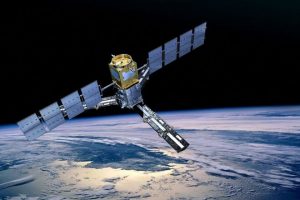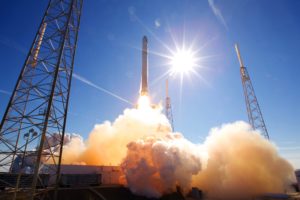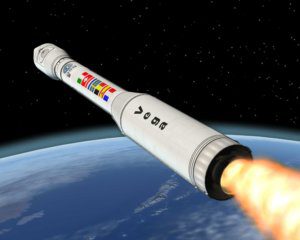
Another batch of Starlink satellite Internet stations has been delivered to Ukraine, Deputy Prime Minister, Minister of Digital Transformation Mykhailo Fedorov said.
“Another batch of Starlink is in Ukraine. The future is in technology. Technologies today help Ukrainians, help the new good to defeat the old evil. The future belongs to Ukraine! Thank you Elon (SpaceX co-founder Elon Musk – IF)! Thank you Poland!” Fedorov said in his Telegram channel.
As reported, Musk refused to block Russian news agencies on the StarLink network.
The first batch of Starlink satellite Internet stations arrived in Ukraine on March 1, 2022, the second on March 10.
Starlink became active on the territory of Ukraine on February 27, 2022.

President of Ukraine Volodymyr Zelensky watched online the launch of the Ukrainian Sich-2-30 satellite into orbit, which took place from the launch site at Cape Canaveral in Florida (U.S.), the press service of the head of state reported.
“I believe that this is the beginning of a new phase of the space program of our state. Thanks to the Ukrainian satellite Sich-2-30, we will receive information not only from our partners, but also our own. This is very important,” the President said.
Together with Volodymyr Zelensky, the launch was observed by Head of the Office of the President Andriy Yermak, Secretary of the National Security and Defense Council Oleksiy Danilov, First Vice President of the National Academy of Sciences of Ukraine Volodymyr Horbulin, Head of the National Space Control and Testing Center Volodymyr Prysiazhny.
This spacecraft is a modified version of the Sich-2 satellite. It was delivered into Earth orbit by a SpaceX Falcon 9 launch vehicle. The last launch of a Ukrainian satellite took place more than ten years ago.
Chief designer and head of the design bureau of spacecraft, measurement systems and telecommunications at Yuzhne Design Bureau Kostiantyn Bilousov said that Sich-2-30 will provide Ukraine with access to information that it has not had for the past ten years.
According to him, the satellite is designed to receive digital images of the surface of our planet, which can be used in land use, agriculture and forestry, cartography, to control water resources and monitor emergencies and natural disasters in the field of security and defense when illegal activities are detected.
The Ukrainian satellite is also designed to monitor the main parameters of neutral and charged particles of the Earth’s ionosphere and measure the dose of accumulative radiation from cosmic radiation.
After launch, the satellite will be involved in the European Union’s Copernicus Earth Observation Program.
Head of the State Space Agency of Ukraine Volodymyr Taftai said that a lot of work had been done to fulfill Zelensky’s assignment regarding the launch of this satellite.
“We have not launched our satellites for more than eleven years. And this is actually a new era in the launch of Ukrainian-made satellites. I really hope that this is the first of eight satellites that will be manufactured as part of a strategic program that is awaiting approval by the Verkhovna Rada of Ukraine,” he said.
The spacecraft was developed and manufactured by SE Yangel Yuzhnoye (Pivdenne) Design Bureau together with the Ukrainian enterprises “Khartron-Arkos LTD” (Kharkiv), “NPP “Khartron-Yukom” (Zaporizhia), “Protection and automation of objects NIIRV” (Kharkiv), CB “Arsenal” (Kyiv), State Research Enterprise “Konex” (Lviv), Lviv Center of the Space Research Institute of the National Academy of Sciences of Ukraine, SE “Kyivprylad”.

Ukraine plans to launch the remote sensing spacecraft Sich 2-30 (2-1) into Earth orbit by the end of 2021, Deputy Prime Minister, Minister for Strategic Industries of Ukraine Oleh Urusky has said.
As reported on the website of the Ministry for Strategic Industries of Ukraine, he announced this during a meeting with spacecraft developers and customers of satellite services.
“We should take all the necessary measures to ensure that this happens by the end of 2021, the year of the 30th anniversary of Ukraine’s Independence. And this is quite realistic, provided that we work as efficiently as possible and this is an urgent need,” the press service quoted Urusky.
According to him, the presence of such a spacecraft will not only help solve a wide range of problems, both in the interests of the economy and law enforcement agencies, but it will also save budget money that is being spent today on the purchase of services provided by such spacecraft abroad.
The Ministry for Strategic Industries said that organizational and technical issues were discussed during the meeting, as well as projects for the creation of a constellation of satellites from Igor Sikorsky Kyiv Polytechnic Institute and the Pivdenne (Yuzhnoye) Design Bureau were presented.
As a result of the meeting, the need to strengthen cooperation between the State Space Agency of Ukraine, Kyiv Polytechnic Institute and the Pivdenne Design Bureau on joint projects was noted, attention was focused on accumulation of all appropriate resources to solve the tasks in 2021, as well as on taking steps to launch into orbit of the third satellite PolyITAN-3, created by Kyiv Polytechnic Institute.
“There is a paradoxical situation: Ukraine has a significant scientific and technical potential and practically everything in order to have its own constellation of spacecraft in an Earth orbit, however, unfortunately, there is no such constellation. Various reasons can be given in this regard, but the situation needs to be changed,” the deputy prime minister said.
As reported, the Cabinet of Ministers of Ukraine has approved the Concept of the national target scientific and technical space program of Ukraine for 2021-2025.

The European light launch vehicle (LV) Vega with a Ukrainian engine has successfully placed in orbit Italy’s Earth remote sensing satellite PRISMA.
According to the press release of the Pivdenne (Yuzhnoye) Design Bureau, the satellite aboard Vega LV lifted off the European spaceport of Kourou (French Guiana) at 0350 on March 22, 2019. This was the fourteenth launch under the Vega program and the first in 2019.
PRISMA spacecraft with 879 kg weight is a small satellite of the Italian Space Agency (ASI). PRISMA is equipped with an innovative electro-optical instrumentation. The instrument is able to work in numerous, narrow and contiguous bands arranged from the visible to the near infrared (VNIR, Visible and Near InfraRed) and up to the infrared shortwave (SWIR, Short Wave InfraRed). The mission will help in monitoring agricultural activities, water resources and studying main environmental processes. PRISMA began a five-year operational mission.
The Vega was developed by the European Space Agency (ESA) in cooperation with the Italian Space Agency (ASI). It is intended for launching into a solar-synchronous orbit with a height of 1,200 km satellites weighing up to 1,200 kg or into a polar orbit with a height of 700 km satellites weighing up to 1,500 kg.
The propulsion engine for the 4th stage of the PH RD-868P was developed by the Yuzhnoye Design Bureau and manufactured the Yuzhmash PO (both from Dnipro, Ukraine). According to the developer, the new liquid engine is based on the intercontinental ballistic missile carrier (ICBM) RS-20.
A successful test run of the Vega rocket was carried out in February 2012. Since May 2013, ESA has begun commercial operation of the new launch vehicle. Some 30 satellites have been launched into orbit for customers.
In July 2017, Ukrainian participants in the Vega program cooperation extended the contract signed in 2012 with a European contractor – Italian Avio SpA – for the supply of production engines for the Vega rocket until 2020.
The government of Ukraine and the ESA signed an agreement on cooperation in the peaceful uses of outer space in 2008.
The structure of the ESA includes 17 European countries.
Ukraine is currently preparing the creation of an information hub for the implementation of the cooperation agreement with the EU signed in May 2018 in the European space monitoring program Copernicus.

A European Vega light launch vehicle, which has a Ukrainian-made engine, has successfully put the European Space Agency’s Earth Explorer Aeolus satellite into orbit.
The Vega rocket lifted away at 00:20 Kyiv time on August 23 from the Guiana Space Centre to the northwest of Kourou in French Guiana, France (South America), the State Space Agency of Ukraine (SSAU) said on its website. It was the twelfth launch under the Vega program and the first one this year.
Built by the European concern Airbus, the Aeolus satellite weighs 1.35 tonnes and is designed for long-range wind-mapping, it will probe the atmosphere with pioneering ultraviolet laser pulses. It is the first satellite that is able to measure wind speeds, using a laser technology for creating dynamic 3D maps of the earth’s surface winds. Aeolus is equipped with a Light Detection and Ranging (LIDAR) instrument called Aladin, which uses the Doppler effect for determining wind speeds at various altitudes. The satellite is to provide reliable information about global wind conditions. The information is necessary for meteorologists to make better forecasts and for climatologists to enhance the understanding of tropical dynamics and processes relevant to climate variability. The satellite will operate for three years.
The Vega launch vehicle was developed by ESA together the Italian Space Agency (ASI). It is designed to launch small payloads. The launcher is capable of delivering a reference payload mass of up to 1,500 kg into a circular sun-synchronous orbit of 700 km altitude.
The RD-848P engine for the fourth stage of the rocket was developed by Ukraine’s state-owned Pivdenne Design Bureau (Dnipro) and manufactured by Dnipro-based state-owned Pivdenmash. The first successful launch was in February 2012. From May 2013, ESA began using a new launch vehicle on a commercial basis.
In July 2017, Ukrainian participants in the Vega program extended the contract signed in 2012 with the European subcontractor, Avio SpA, for deliveries of engines for the Vega launch vehicle through 2020.
Ukraine’s government and ESA signed a cooperation agreement concerning space cooperation for peaceful purposes in 2008. Some 17 European countries are ESA members.
Ukraine is currently preparing to create an information hub in accordance with a contract signed in May 2018 with the EU on cooperation in the Copernicus Earth observation program.
EARTH EXPLORER AEOLUS, ESA'S, ORBIT, SATELLITE, UKRAINIAN ENGINE, VEGA